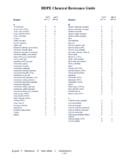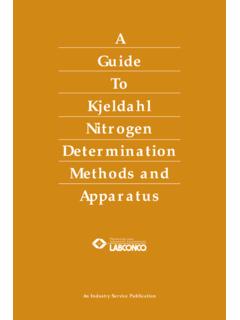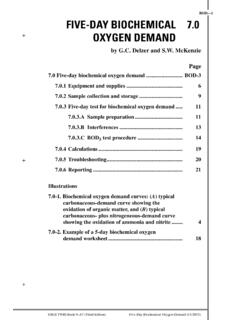Transcription of Technical Information Sodium Nitrite grades
1 Sodium Nitrite for Pickling Salt (E 250) Sodium Nitrite Tech. RWSodium Nitrite Tech. USodium Nitrite Solution N 25 39 % Sodium Nitrite Solution N approx. 40 % Sodium Nitrite Solution S 25 39 % Sodium Nitrite Solution S approx. 40 %Auxiliaries for the chemical and pharmaceutical industries, the textile industry, hardening technology and many other in certain Information M 6066 eMay 2002 (Diet)Supersedes M 6066 e of June 1996 = reg. Marke der BASF AktiengesellschaftSodium Nitrite gradesChemicalsSodium Nitrite for Pickling Salt (E 250) Sodium Nitrite Tech. RWSodium Nitrite Tech. USodium Nitrite Solution N 25 39 % Sodium Nitrite Solution N approx. 40 % Sodium Nitrite Solution S approx. 40 % Sodium Nitrite Solution S 25 39 %Chemical nameSodium nitriteChemical formulaNaNO2 Molecular g/molCAS supplied and packagingSodium Nitrite Tech. Uand Sodium Nitrite for Pickling Salt (E 250)are untreated products and therefore tend to cake. Sodium Nitrite a free-flowing grade treated with an anti-caking Nitrite Tech.
2 U and Tech. RWare supplied in 25- and 50-kg PEbags. Sodium Nitrite Tech. RWcan also be supplied in FIBCs (Big Bags)holding up to 1 Nitrite for Pickling Salt (E 250)is only supplied in 25-kg Nitrite Solutionsare transported only in road tankers, tank containers or rail tank wagons within Nitrite is a fine crystalline, faintly yellowish salt. Sodium nitriteabsorbs moisture from the air when the relative humidity is as low as 60 % and to an increasing extent as it rises. In unfavourable circumstances, asa result of this water absorption, the product can cake very rapidly andthus become hard without undergoing any change in chemical are broken up by moving the containers, e. g. by standingthem melting point of the dry product is about 280 C. Sodium Nitrite isfreely soluble in water. Solubility and density of the solution are shown inthe following two 6066 e May 2002 Fig. 1 Solubility of Sodium Nitrite in waterFig 2:Density of Sodium Nitrite solutions 13501300125012001150110010501000 Density in g/lConcentration in g NaNO2/100 g solution02468101214161820222426283032343 638404244 Density of aqueous Sodium Nitrite solutions6563615957555351494745434139373 53331292725 Concentration in g/100 gTemperature in C-20 -16 -12 -8 -4 048 12 16 20 24 28 32 36 40 44 48 52 56 60 64 68 72 76 80 84 88 92 96 100 Solubility of Sodium Nitrite in water3/8M 6066 e May 20024/8M 6066 e May 2002 Typical values for particle size distribution are shown in the following diagramFig.
3 3 Particle size distribution of Sodium nitriteProduct specificationThe values and test methods given in the following product specificationscorrespond to those that are valid at the time the Technical data sheet isproduced. If interested, please ask for the current product specificationsbecause some changes may have occurred. Only the values in the relevantspecification sheets supplied are then Nitrite for Pickling Salt Product without added anti-caking agent; hardens rapidly.(E 250)CharacteristicUnitAverageSpecificati onTest methodsvalueSodium nitriteg/100 nitrateg/100 chromatographySodium carbonatemg/kg200max. 600 TitrimetrySodium chloridemg/kg20max. 50 TitrimetrySodium sulphatemg/kg40max. 50 Ion chromatographyWater (loss on drying)g/100 residuemg/kg20max. 50 GravimetryTotal heavy metals (as Pb)mg/kg max. 10 FCC IV method*Leadmg/kg< 5 Atomic spectrometryArsenicmg/kg< spectrometryMercurymg/kg< spectrometry* FCC = Food Chemicals Codex1009080706050403020100 Residue on sieve in g/100 gParticle size in particle size distribution of Sodium nitriteSodium Nitrite Tech.
4 RWProduct with anti-caking agent based on naphthalene methodsvalueSodium nitriteg/100 nitrateg/100 chromatographySodium carbonatemg/kg200max. 600 TitrimetrySodium chloridemg/kg20max. 50 TitrimetrySodium sulphatemg/kg200max. 300 Ion chromatographyWater (loss on drying)g/100 residuemg/kg20max. 50 GravimetrySodium Nitrite Tech. UProduct without added anti-caking agent; hardens methodsvalueSodium nitriteg/100 nitrateg/100 chromatographySodium carbonatemg/kg200max. 600 TitrimetrySodium chloridemg/kg20max. 50 TitrimetrySodium sulphatemg/kg40max. 50 Ion chromatographyWater (loss on drying)g/100 residuemg/kg20max. 50 GravimetrySodium Nitrite Solution N 25 39 % Sodium Nitrite solutions N are clear, faintly yellowish liquids with theSodium Nitrite Solution N following product specification:approx. 40 %CharacteristicUnitAverageSpecificationT est methodsvalueSodium nitriteg/100 g25 4024 41 TitrimetrySodium nitrateg/100 4 Ion chromatographypH (40 % solution) measurementDensity (20 C)g/cm3 6066 e May 2002 Sodium Nitrite Solution S 25 39 % Sodium Nitrite solutions S are clear, faintly yellowish liquids with theSodium Nitrite Solution S following product specification:approx.
5 40 %CharacteristicUnitAverageSpecificationT est methodsvalueSodium nitriteg/100 g25 4024 41 TitrimetrySodium nitrateg/100 chromatographySodium carbonatemg/kg90max. 450 TitrimetrySodium chloridemg/kg10max. 20 TitrimetrySodium sulphatemg/kg15max. 20 Ion 3 Ion chromatography/atomic spectrometryCalciummg/kg3max. 8 Ion chromatography/atomic spectrometrypH (40 % solution) measurementDensity (20 C)g/cm3 the Sodium Nitrite grades onlySodium Nitrite for Pickling Salt (E 250)is permitted for use as a food additive subject to special condi-tions. The product is produced, filled and despatched in accordance withHACCP guidelines. The purity of Sodium Nitrite for Pickling Salt (E 250)meets the limit values for a food additive and those of the European Pharmacopoeia characteristicsSodium Nitrite is both an oxidising agent and a reducing agent. Violent andin some cases even explosive reactions can occur with ammonium salts,amides and products that contain these substances.
6 Sodium Nitrite cansimilarly react violently with reducing agents such as alkali sulphites nitrous acid forming on acidification decomposes rapidly to form brownnitrous gases. The nitrous acid reacts with some substances to form diazoor nitroso compounds. These reactions are utilised for numerous substances that have been heavily impregnated with nitritesolution and then dried burn much more readily. Sodium Nitrite and itssolutions do not attack steel, iron and many other metals. Similarly, rubber,plastics, glass, porcelain and ceramics are resistant to Sodium Nitrite andits solutions . Comprehensive Information on the resistance of variousmaterials to Sodium Nitrite is given in the DECHEMA material 6066 e May 2002 UseIn the food industrySodium Nitrite for Pickling Salt (E 250)may be employed as a preser-vative for the production of Nitrite pickling salt only in accordance with theprovisions of the permitted additives regulations, EC Directive 95/2 or theCode of Federal Regulations (21 CFR) of the Food and Drug Administrationor other local guidelines restricted to a few foods and in the maximumamounts specified the chemical and For the manufacture of azo dyes, diazo compounds and nitroso isonitroso and pharmaceutical industriescompounds.
7 For flushing butadiene tanks and as a component of heattransfer textile dyeing and printingFor diazotisation in the manufacture of azo dyes. For oxidising dyeings andprints with leuco vat dyes. To protect against overreduction in dyeing andprinting with certain vat dyes. For the accelerated oxidation of vat dyesthat are difficult to reoxidise. For bleaching natural the metal industryAs an accelerator in cold phosphating. For the production of baths for thebluing of steels. For the bronzing and quenching of steel. In descalingsteels and cast iron. As an additive to alkaline pickling baths for aluminiumand aluminium alloys and for neutral cleaning and passivating baths. As anauxiliary in the treatment of the construction industryAs an additive in the manufacture of concrete to increase its strength andas a corrosion inhibitor in reinforced a corrosion inhibitor for iron, steel and water cooling circuit the rubber industryAs an auxiliary for the production of rubber as hardener, accelerator, retarder and the chemical- Technical For the manufacture of corrosion inhibitors and corrosion-inhibiting industrypapers.
8 In the manufacture of aqueous emulsion paints. As an additive toenamel frits and for the manufacture of products for preventing corrosionof heating oil storage tanks. In cutting and drilling oils, in hydraulic fluidsand in lubricants. In the oil stabilising the colour of vinyl effectsSodium nitritepromotes methaemoglobin formation. The symptoms arecongestion in the head, nausea, hypotension, cyanosis and circulatorycollapse. The lethal dose for adults is 4 6 nitriteis classified as water-polluting (water hazard class 2)Safety notesSodium Nitrite must bear a hazard warning label in accordance withAppendix 1 of Directive 67/548/EEC:Hazard symbols:O, T, NR phrases:8, 25S phrases:45 Sodium Nitrite solutions must be labelled as follows: Sodium Nitrite concentration > 1 to < 5 % by weight:Xn, R 22 Sodium Nitrite concentration > 5 to < 25 % by weight: T, R 25, S 45, S 61 Sodium Nitrite concentration 25 % by weight:T, N, R 25, R 50, S 45, S 61 Further details can be found in the corresponding safety data 6066 e May 2002 Transport and storageIf stored in a cool dry place Sodium Nitrite can be kept for years.
9 However,the untreated product becomes hard after 1 2 weeks as a result of caking. The free-flowing properties of the treated (RW) grade depend to a large extent on external influences. If the product is stored at a lowand as constant a temperature as possible and is subject to minimal pres-sure, e. g. by not stacking pallets on top of each other, it can retain itsfree-flowing properties for up to one Nitrite for Pickling Salt (E 250) must be stored and transportedin accordance with the guidelines for food Nitrite is an oxidising substance. The storeroom must be suitablefor this type of product. The local building regulations must be of the danger of violent reactions Sodium Nitrite must notbestored and transported together with the following products: ammoniumsalts such as ammonium sulphate, ammonium chloride and ammoniumhydrogen carbonate, ammonium-containing preparations such as nitroge-nous fertilisers, amides such as urea and readily oxidisable products suchas Sodium bisulphite.
10 Because of the danger of nitrogen oxide formationsodium Nitrite must be transported and stored separately from of its toxicity care must be taken to ensure that Sodium Nitrite isnot confused with common salt or cattle salt. It must not be stored ortransported together with food or animal Information submitted in this publication is based on our current knowledge and experience. In view of the many factors that may affect processing and application, these data do not relieve processors from the responsibility of carrying out their own tests and experiments; neither do they imply any legally binding assurance of certain properties or of suit-ability for a specific purpose. It is the responsibility of those to whom we supply our products to ensure that any proprietary rights and existing laws and legislation are 6066 e May 2002 BASF AktiengesellschaftMarketing Inorganic Chemicals Europe67056 Ludwigshafen, GermanyPrinted in Germany




